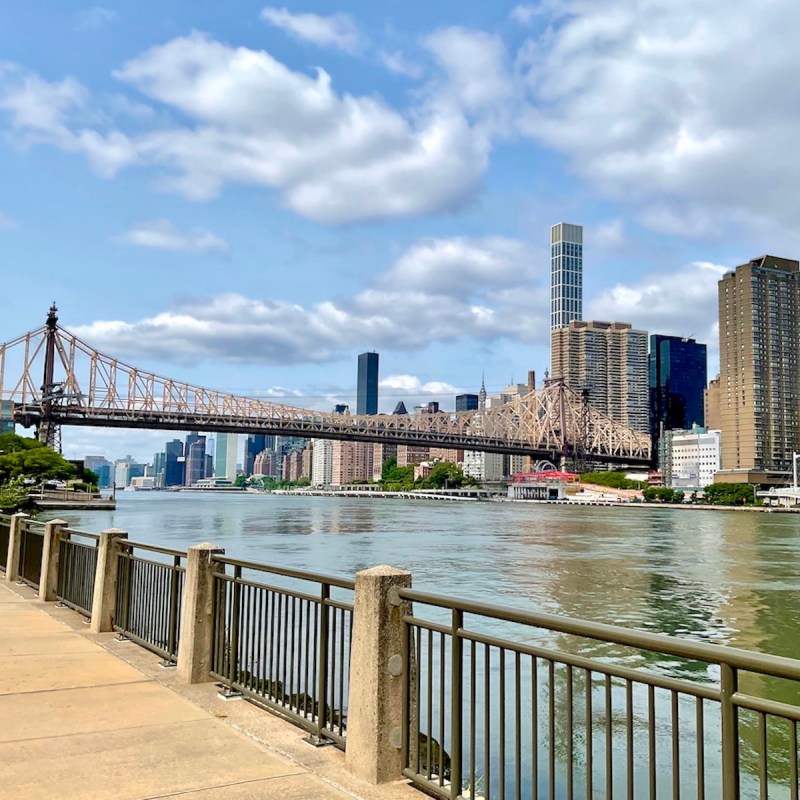
Just yards from Manhattan across the East River lies a little gem in the middle of a concrete jungle. Enjoy solitude and peacefulness from the noise, people, cars, and chaos of the hectic urban sprawl in New York City. Roosevelt Island has loads of green spaces, an uber-hip hotel, and a wonderful sightseeing tram ride with amazing views of Manhattan and the East River. The small, 2-mile-long, sliver-shaped island has about 18,000 residents, 3.5 miles of flat bicycle and walking paths, restaurants, and many parks.
Videos by TravelAwaits
History Of Roosevelt Island
It hasn’t always been known as a popular place due to its checkered history throughout the years. Currently called Roosevelt Island — since 1973 — in honor of Franklin Delano Roosevelt, the island has had several names and at one time was known as the “Welfare Island.” It was initially used by Native Americans to raise hogs and later occupied by the shamed British Captain John Manning after surrendering New York to the Dutch in 1664. The island was passed down and was later inherited, becoming known as Blackwell’s Island in 1686 due to marriage. The island then became home to a mental asylum, a prison, and a smallpox hospital. During the 1920s, the city reformed the island and started establishing hospitals. Now, the island is comprised of a quiet residential area with businesses that support the locals. A newly opened Cornell University Tech Campus and easy public transportation add to the island’s charm. A large five-star rehabilitation center to help patients recover is located on the northern tip.

1. Ride The Roosevelt Tram
Getting to the island is quick, easy, and affordable. Hop on the Roosevelt Island Tram and soar 250 feet for a quick 4-minute ride over the East River — just $2.75 each way. Board at 59th and 2nd Avenue in Manhattan or load at the island. You can’t miss the large red 120-person-capacity tram as it travels next to the Queensboro Bridge!
Pro Tip: The locals refer to the bridge as the “59th Street Bridge,” which is not the official name of the “Ed Koch Queensboro Bridge.”

2. Bicycle Around The Island
Consider renting a Citibike to pedal effortlessly around the flat island. I rented a bike and rode the complete 3.5-mile bike path in less than an hour! There are two well-placed bike loading stations making getting on and off centrally located next to mass transportation. I made mental notes of where I wanted to return and enjoyed a take-out lunch on one of the many benches looking towards Manhattan. It’s a snap because you can’t get lost on this small island; it’s less than a football field wide!
Pro Tip: If you decide to walk and get tired, there is a Free Red Bus every 15 minutes that circles the island with many hop-on, hop-off stops.

3. Public Bus, Subway, And Public Ferry
If the tram isn’t your first choice for getting to the island, there are many ways to utilize the easy and affordable public transportation. You could easily hop on the Q102 public bus that runs onto the island and makes a complete circuit every 20 minutes from Queens. Or for a faster, more direct route from Queens or Manhattan, take the F train and exit mid-island. Most transportation spots have access to the free Red Bus, Citibike, public bus, or tram stations. You could also get an Uber or cab and drive over the bridge from Astoria — a small quaint area of Queens. There is also access to the NYC ferry for a very affordable boat cruise up the East River to and from the island. Regardless of what mode of public transportation you choose, access to the island couldn’t be easier.

4. Where To Eat
Although the island is small, it packs a mighty punch in options for food. The hippest place to eat is at the Graduate New York. Dine at their uber-hip, 18th-floor rooftop bar, The Panorama Room, with amazing views, or their American Lobby restaurant. If this isn’t your speed, there are several local restaurants in the middle of the island. Hands down my number one choice in a place like this is to grab food from one of the grocery stores and have a fabulous impromptu picnic sitting on a bench, with the majestic skyline as my backdrop.
Pro Tip: Grill up something yummy at the public barbecue grills available for free near Octagon Park, home of the former insane asylum.

5. Visit The Parks Of Roosevelt Island
This tiny island has at least 12 parks with walking paths, greenery, park benches, and areas to stretch out and run. The two most popular parks are Lighthouse Park on the north end and FDR Four Freedom State Park at the south end. Take the free Red Bus to either park from anywhere on the island.
Be sure to visit The Girl Puzzle exhibit at Lighthouse Park. It’s a fascinating story about a female investigative reporter, Nellie Bly, in the late 1800s. Bly shed light on the horrific conditions of the mental asylum, posing as a patient and then writing a scathing exposé.
Pro Tip: Stop by and see the Island’s Last Chance Canadian Geese Sanctuary along the FDR walkway and see the darling goslings.
6. Play Tennis Or Pickleball
Stop off at the Roosevelt Island Racquet Club and hit a few balls. If you forgot your tennis racquet, the club lets “loaners” out. Showers and towels are available for a small fee. Behind the club, the city offers two free pickleball courts. Bring your own paddles! Call first to reserve the tennis courts. Be a kind visitor and donate a can of tennis balls if you “borrow” a loaner tennis racquet.
Pro Tip: Look for large yellow vent tubes on sidewalks. Roosevelt Island is the only U.S. city to use an automated vacuum waste system, which moves 5.8 tons of trash daily. Residents put their trash in collectors and it’s sucked down below street level into a central facility. No Loud trash trucks here!
7. The Blackwell House
Soak up a little history on your stroll through the island and visit the historic home of the Blackwells, former owners of the island during the late 1700s. Entry is free. Learn how the island changed names from Manning to Blackwell.

8. Smallpox Hospital
Visit the grounds of the first Smallpox Hospital in the country. When smallpox spread rampant in New York City during the 1800s, patients were mandated to isolate on the island at this location to receive care. After the smallpox vaccine was created, the hospital closed. The ruins are currently in repair and hopefully will open in the future for tours. During the night, “up lighting” creates a spooky scene and highlights the ivy-covered stone building.
Related Reading:
